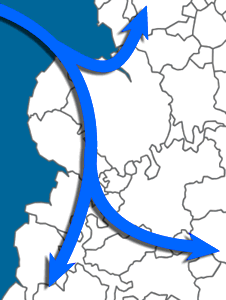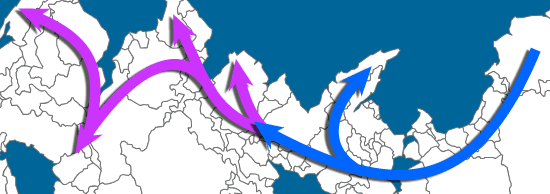New Continents
Almost 7,000 years ago the Kȳrimyr disappeared (ca. 700 LR). They are believed to have migrated east across the Mar Kàrāyn to Teréðor, for the people that appeared there share some linguistic artifacts with the present day Varsti. Some sages believe that the Kȳrim must have crossed a Jȳar land-bridge; though there are no historic mention of such a causeway spanning the Endless Sea. The Yrūn of Teréðor called themselves the Na’Lir, which is similar to the Varsti word “Nelir” meaning Lost.Circa 500 – 1000 LR. Emergence of the Yrūnyr heralds the Third Age of Teréth End. The founding the Urzar civilization. Rise of the Na’Lir, inheritors of the wayward Nāzar. The allegiance of the immortal Dwürden. Wrath of the Eylfāe. Settlement in the Uncharted Lands. The Vulmàryr, united tribes of Vuldir and Nāzar, push past the immortal antagonists and enter western Vulmùra. With the Third Migration ended, the Yrūni have settled every continent but one.
The Na’Lir found themselves in a hostile land. Like their distant Vuldir brethren, their wandering had led them to the threshold of a sacred Eylfāe region (i.e., the Central Vale). With the two encounters occurring within a hundred years of one another, the Eylfāe grew paranoid and suspected Dwürden machinations. In response, Anàhlāri armies stormed from the interior of the Teréðor and slaughtered the Yrūn by the thousands (ca. 785 LR). The Eylfāe’s reaction to the Yrūni bumbling assured the Dwürden Kings that the new race were not pawns of their enemy. The Dwürden were also impressed that despite the punishment the Yrūn received at the hands of the Eylfāe troops, they continued to fight (though according to Dwürden accounts, not one Eylfāe was lost). News of this spread quickly to each of the three Hearts (e.g., Dergàrdgurün, Felhòrmorgrūmeð, Gemürjordok) and within months Yrūn throughout the world were befriended by the Immortal Dwürden.
Despite their new allies, the Yrūn suffered terrible loses and were pushed south along the Teréðori coast. Whenever they could, the Na’Lir found refuge in the mountain holds of the Dwürden who helped them along the way. At each Dwürden hold, the Immortal race mended and provisioned the Na’Lir, for they were fatigued from their endless walking, and bloodied from battles they could not win. As the Yrūn continued their journey south, their hosts mobilized an army the likes of which had not been seen since the Second Age. As the Eylfāe moved to intercept the weary Yrūn, the Dwürden emerged from nearby canyons and caves, striking deeply into their flanks. Horns sounded through the hills as the Dwürden Bear Riders charged into the battle with their hunting dogs that could tear the arms from Ortor. In one battle (ca. 790), the Eylfāe were diverted from their murderous pursuit.
The Na’Lir moved far from the lands of the Eylfāe, settling at present-day Virāy Syldar and a place the Dwürden called Juduð which was filled with the unnamed ruins of a forgotten people. Others moved inland over western mountains and into the verdant Shar Cradle.
While the Kȳrimyr were running for their lives deeper into the unknown, the Nāzar of Lyrast were having problems of their own. Though the Nāzar had adapted quickly to the cold climes of northern Lyrast, it did not take long for their burgeoning population to test the limits of their resources. After a run of particularly brutal winters and warfare between the incipient kingdoms, many people again began to move. By the early 8th century LR, there was a massive east-to-west migration along the northern reaches of Lyrast. It did not take long for the Nāzar to encounter the towns and villages settled by the Vuldir centuries before. The land of the Vuldir was more temperate than those of the Nāzar, but the winters had still taken their toll and could not support the numbers that were pouring from that region. Within a short time, both Vuldir and Nāzar were moving west in search for greener pastures.By the end of the 8th century LR the lands of Old Vulyra had become inhospitable. The Eylfāe of the Anahl had begun sending forays into the Yrūni lands, slaughtering farm-keeps and villages. The people of Old Vulyra had no idea that their troubles were related to the struggles of those in Teréðor, but it wouldn’t have mattered if they had. Unlike the impoverished refugees of that other land, the Yrūnyr of Vulmùra fought back. Despite inferior weapons and primitive Spirit magics, the Vulmar (as the combined population called themselves) were able to keep the Eylfāe at bay. The Yrūnyr were no match for the Immortals one-on-one, but the Vulmar were fearless in the face of death and the Eylfāe had no desire to risk their lives fighting primitives. Soon the Vulmàri armies were able to push back against the Eylfāe’s defense of the Vulmùri mainland, opening a northern passage along the coast. Over the next few hundred years (bet. 900-1300 LR), tens of thousands of people made there way along the trail, skirting above the Eylfāe lands to the south. Although the trek cost thousands their lives, the promised land at the other end was better than they could have hoped for.

